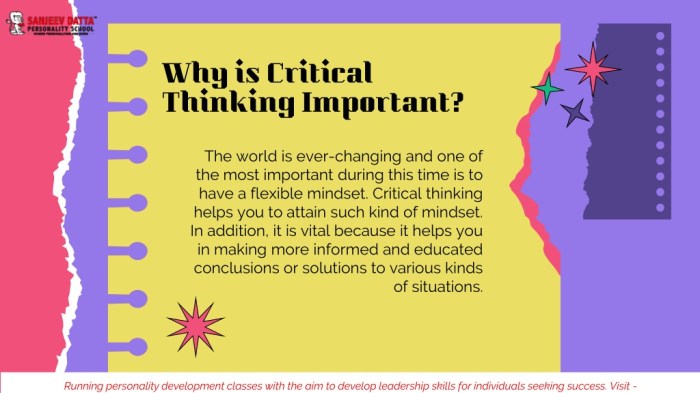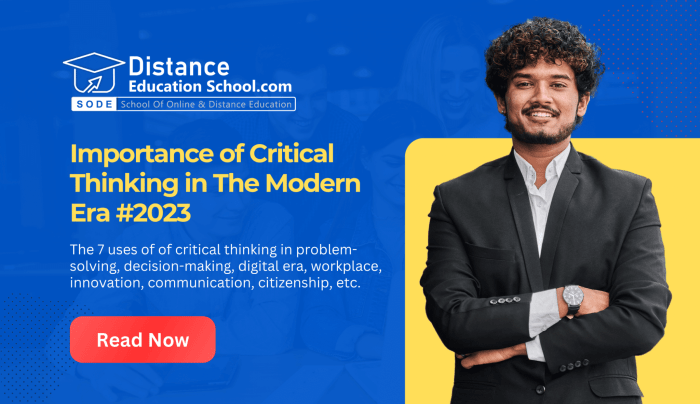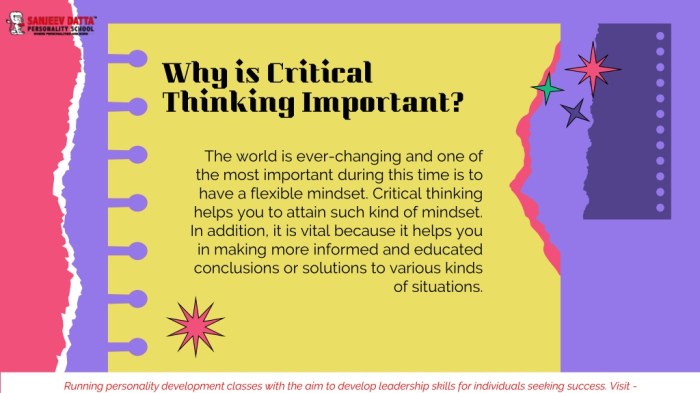
Why critical thinking essential your success and how you can improve – Why critical thinking is essential for your success and how you can improve it, this exploration dives deep into the vital role of critical thinking in achieving personal and professional goals. We’ll examine its core components, its impact on various aspects of life, and provide practical strategies to hone this essential skill.
This journey will cover defining critical thinking, exploring its crucial role in success, and outlining practical steps to enhance your critical thinking skills. From evaluating information to overcoming obstacles, we’ll equip you with the tools needed for continuous improvement.
Defining Critical Thinking

Critical thinking is a cornerstone of success in any field. It’s not just about accumulating knowledge; it’s about actively evaluating information, identifying biases, and forming reasoned judgments. It’s a complex process involving several interconnected cognitive skills, and mastering it is crucial for navigating the complexities of the modern world.Critical thinking goes beyond simply recalling facts. It involves analyzing, interpreting, and evaluating information to form your own informed opinions.
It’s a proactive approach to understanding, not a passive reception of data. It demands a willingness to question assumptions and consider alternative perspectives.
Key Components of Critical Thinking
Critical thinking encompasses several essential components. These include analysis, evaluation, inference, explanation, and self-regulation. Analysis involves breaking down complex ideas into smaller parts to understand their structure and relationships. Evaluation assesses the validity and reliability of information. Inference involves drawing logical conclusions from evidence.
Explanation articulates the reasoning behind judgments and conclusions. Self-regulation refers to monitoring and adjusting one’s own thought processes. By mastering these components, you develop a more robust and reliable approach to problem-solving and decision-making.
Distinguishing Critical Thinking from Related Skills
Critical thinking is closely related to, but distinct from, other cognitive skills like problem-solving and decision-making. While these skills overlap, critical thinking forms the foundation for effective problem-solving and sound decision-making. Problem-solving focuses on finding solutions to specific issues, while critical thinking provides the framework for evaluating the problem itself and the potential solutions. Decision-making involves choosing a course of action, and critical thinking informs the process by helping you evaluate the available options and their potential consequences.
Intellectual Humility and Courage in Critical Thinking, Why critical thinking essential your success and how you can improve
Intellectual humility acknowledges the limits of one’s own knowledge and understanding. It involves recognizing that there may be other valid perspectives and that you may be wrong. Intellectual courage, on the other hand, is the willingness to critically examine your own beliefs and values, even if they are challenged by new information. This willingness to confront uncomfortable truths is essential for developing a robust and nuanced understanding of the world.
Critical thinking is key to unlocking your potential and achieving success. It’s about analyzing information, forming reasoned judgments, and making sound decisions. Want to boost your critical thinking skills? Consider exploring the amazing benefits of broccoli, a nutrient-packed superfood! Did you know that amazing benefits of broccoli 5 refreshing recipes can be a great way to learn how to incorporate this healthy veggie into your diet?
Incorporating healthy habits like eating nutritious foods and practicing critical thinking can lead to a more fulfilling and successful life.
Types of Critical Thinking Approaches
Different approaches to critical thinking exist, each with its own strengths and weaknesses. These methods allow for various ways of evaluating information and drawing conclusions.
| Type of Approach | Description | Example |
|---|---|---|
| Deductive | Starts with general principles and applies them to specific cases. The conclusion is guaranteed if the premises are true. | All men are mortal. Socrates is a man. Therefore, Socrates is mortal. |
| Inductive | Starts with specific observations and draws general conclusions. The conclusion is probable, not guaranteed. | The sun has risen every day for billions of years. Therefore, the sun will probably rise tomorrow. |
| Abductive | Starts with an observation and seeks the most plausible explanation. The conclusion is the most likely explanation, but not necessarily the only one. | The lights are out, and the car is gone. Therefore, someone left. |
The Role of Critical Thinking in Success
Critical thinking isn’t just a valuable skill; it’s a cornerstone of personal and professional achievement. It empowers individuals to navigate complex situations, make sound judgments, and solve problems effectively. Developing this skillset unlocks a multitude of opportunities for growth and advancement in all aspects of life. This section delves into the significant contributions of critical thinking to various facets of success.Critical thinking transcends mere memorization and rote learning.
It’s about actively engaging with information, analyzing its validity, and forming reasoned conclusions. This active process is essential for navigating the complexities of the modern world, where information is readily available but not always accurate or reliable. The ability to discern fact from fiction, identify biases, and evaluate arguments is paramount for success in any field.
Contribution to Personal Growth
Critical thinking fuels personal growth by encouraging self-reflection and evaluation. By analyzing personal beliefs and values, individuals can identify areas for improvement and develop more effective strategies for achieving their goals. This introspection leads to a deeper understanding of oneself, fostering greater self-awareness and confidence.
Contribution to Professional Growth
In the professional realm, critical thinking is indispensable. It enables individuals to analyze situations, identify problems, and develop innovative solutions. This skillset is highly valued by employers, who recognize its ability to drive productivity, efficiency, and creativity. Strong critical thinkers often excel in problem-solving and decision-making, which are key components of success in any profession.
Examples of Critical Thinking in Action
Critical thinking is crucial in various scenarios. For instance, a project manager needs critical thinking to assess project timelines, resource allocation, and potential risks. Similarly, a medical professional needs critical thinking to diagnose illnesses and develop treatment plans based on patient data. In a business context, critical thinking is necessary for evaluating market trends, understanding customer needs, and formulating effective marketing strategies.
Enhancing Decision-Making Processes
Critical thinking plays a pivotal role in enhancing decision-making processes. It encourages a systematic approach to problem-solving, involving the careful consideration of various perspectives and potential outcomes. This process, in turn, minimizes impulsive decisions and fosters more informed choices.
Impact on Problem-Solving and Innovation
Critical thinking is fundamental to problem-solving and innovation. By analyzing problems from multiple angles, individuals can identify root causes and develop innovative solutions that address the core issues. This process fosters creativity and adaptability, enabling individuals to find novel approaches to complex challenges.
Impact on Innovation
Critical thinking is the catalyst for innovation. By evaluating existing solutions and identifying their limitations, individuals can develop new approaches and strategies that lead to more effective and efficient outcomes. This innovative spirit is a key factor in driving progress and growth across various sectors.
Career Fields Valuing Critical Thinking
| Career Field | Specific Applications of Critical Thinking |
|---|---|
| Medicine | Diagnosis, treatment planning, ethical decision-making |
| Engineering | Problem-solving, design optimization, risk assessment |
| Law | Legal analysis, argumentation, evidence evaluation |
| Business | Market analysis, strategy development, financial forecasting |
| Education | Curriculum development, student assessment, pedagogical innovation |
Identifying and Evaluating Information: Why Critical Thinking Essential Your Success And How You Can Improve
Knowing how to evaluate information is crucial in today’s world, saturated with diverse and often conflicting viewpoints. We encounter information from various sources, ranging from trusted news outlets to social media posts. Developing the skill to critically assess the credibility of these sources, identify potential biases, and recognize logical fallacies is essential for making sound judgments and avoiding misinformation.
This process strengthens our understanding of complex issues and fosters informed decision-making.Evaluating information is not just about finding the “right” answer, but about understanding the context and limitations of the source. This includes considering the author’s perspective, the intended audience, and the potential motivations behind the information presented. By developing these skills, we can become more discerning consumers of information, contributing to a more informed and less susceptible society.
Evaluating Source Credibility
Determining the credibility of a source involves a multi-faceted approach. Consider the author’s expertise, their potential biases, and the source’s reputation. Reputable sources typically have a history of accuracy and objectivity, while sources with a vested interest might present biased information. For instance, a news article from a well-known and respected journalistic organization is more likely to be credible than a blog post from an anonymous individual.
The reputation of the author and the publication are significant factors. Look for evidence of fact-checking and a commitment to journalistic integrity.
Identifying Biases and Logical Fallacies
Recognizing biases and logical fallacies in arguments is equally important. Biases are systematic errors in thinking that can influence our judgments. Logical fallacies are flaws in reasoning that undermine the validity of an argument. Understanding these concepts allows us to evaluate arguments more effectively and avoid being misled by flawed reasoning.Examples of logical fallacies include:
- Ad hominem attacks: Attacking the person making the argument instead of addressing the argument itself. For example, dismissing a climate scientist’s findings simply because they work for a university known for environmental research.
- Appeals to emotion: Using emotional appeals rather than logical reasoning to persuade. An example would be a political advertisement focusing on emotional patriotism instead of presenting factual policy information.
- Straw man fallacy: Misrepresenting someone’s argument to make it easier to attack. This happens when someone paraphrases an opponent’s argument to make it seem weaker than it actually is.
These are just a few examples; there are many other types of logical fallacies to be aware of. It is important to be able to identify and understand them to be a discerning consumer of information.
Information Source Types
Various types of information sources exist, each with its own strengths and weaknesses. News articles, research papers, and social media posts are examples of information sources.
- News articles from reputable sources often provide comprehensive reports on current events, but their perspectives might be influenced by editorial choices.
- Research papers typically provide in-depth analysis based on evidence, but they might have limitations in scope and generalizability.
- Social media posts can spread information rapidly, but they are often unreliable due to lack of verification and potential for misinformation.
Importance of Verification
It is critical to verify information before accepting it as fact. Information verification involves checking multiple sources, looking for corroborating evidence, and cross-referencing details. This process helps ensure accuracy and avoid spreading misinformation. For example, if a social media post claims a scientific discovery, it’s important to check reputable scientific journals or news outlets for independent confirmation.
Assessing Online Information Reliability
Evaluating online information requires a structured approach.
| Step | Action |
|---|---|
| 1 | Identify the source: Who created the content? What is their background and expertise? |
| 2 | Evaluate the author’s credibility: Look for credentials, affiliations, and any potential biases. |
| 3 | Check for supporting evidence: Does the information include citations, links to reliable sources, or verifiable facts? |
| 4 | Look for corroboration: Can the information be verified through other sources? |
| 5 | Consider the date of publication: Is the information current and relevant? |
| 6 | Examine the language and tone: Is the language objective and factual, or is it emotionally charged? |
| 7 | Assess the overall website: Is the website reputable and trustworthy? |
Developing Critical Thinking Skills
Cultivating critical thinking is an ongoing process, not a destination. It requires consistent practice and a willingness to challenge your own assumptions and perspectives. This section explores practical methods for enhancing your active listening, argument analysis, and questioning skills, ultimately leading to more robust and well-reasoned conclusions.
Improving Active Listening Skills
Active listening is more than just hearing; it’s about understanding the speaker’s message, both verbally and nonverbally. To improve your active listening skills, focus on understanding the speaker’s perspective, rather than formulating your response. This involves making a conscious effort to maintain eye contact, avoid distractions, and show genuine interest in what the speaker is saying. Paraphrasing and summarizing the speaker’s points demonstrates your comprehension and encourages clarification.
- Pay close attention to nonverbal cues. Body language, tone of voice, and facial expressions often convey more information than the spoken words. Recognizing these cues can help you understand the speaker’s underlying emotions and intentions.
- Ask clarifying questions. Instead of interrupting, ask thoughtful questions to ensure you understand the speaker’s message fully.
- Avoid interrupting. Allow the speaker to complete their thoughts before responding.
- Focus on understanding, not just responding. Listen with the intention of grasping the speaker’s perspective, rather than formulating your own rebuttal.
Analyzing Arguments and Identifying Assumptions
Effective critical thinkers dissect arguments, identifying the underlying assumptions and evaluating their validity. This involves identifying the conclusion, the supporting premises, and the implicit or explicit assumptions that connect them.
- Identify the conclusion. Determine the main point the argument is trying to establish.
- Identify the premises. Determine the reasons or evidence offered in support of the conclusion.
- Identify the assumptions. Determine the beliefs or values that are taken for granted and connect the premises to the conclusion.
- Evaluate the validity of the assumptions. Assess whether the assumptions are reasonable and supported by evidence.
Asking Clarifying Questions and Challenging Perspectives
Critical thinkers don’t just passively absorb information; they actively seek clarification and challenge perspectives. Asking clarifying questions and challenging perspectives is crucial for a deeper understanding and the avoidance of logical fallacies.
- Ask open-ended questions. These encourage detailed responses and a deeper exploration of the topic.
- Challenge assumptions. Identify underlying assumptions and explore their validity. For example, if someone claims that “all teenagers are lazy,” ask, “How do you define laziness? Are there any exceptions to this statement?”
- Consider alternative perspectives. Explore different viewpoints and interpretations of the same information. Seek out evidence from different sources and consider the potential biases of the information provider.
Constructing Well-Supported Arguments
Developing well-supported arguments is a key aspect of critical thinking. A strong argument presents clear premises, avoids logical fallacies, and supports its conclusion with relevant evidence.
- Use clear and concise language. Ensure your argument is easy to understand and avoids ambiguity.
- Support your claims with evidence. Back up your premises with verifiable facts, data, and examples.
- Avoid logical fallacies. Be mindful of common errors in reasoning and avoid them in your arguments.
- Acknowledge counterarguments. Anticipate potential objections and address them in your argument.
Questioning Techniques for Encouraging Critical Thinking
Different questioning techniques can effectively stimulate critical thinking in various contexts. This table illustrates various questioning techniques and their potential applications.
| Questioning Technique | Description | Example |
|---|---|---|
| Open-ended questions | Questions that encourage detailed responses. | “What are your thoughts on…?” |
| Clarifying questions | Questions that seek to ensure understanding. | “Could you elaborate on…?” |
| Challenging questions | Questions that probe assumptions and perspectives. | “What are the potential downsides of…?” |
| Probing questions | Questions that delve deeper into a topic. | “Why do you think…?” |
| Hypothetical questions | Questions that explore potential scenarios. | “If this were to happen, what would be the outcome?” |
Applying Critical Thinking in Everyday Life

Critical thinking isn’t just a skill for academics or professionals; it’s a powerful tool for navigating the complexities of everyday life. From making informed decisions about purchases to understanding the nuances of interpersonal relationships, critical thinking empowers us to approach challenges with clarity and intentionality. By actively engaging with information, evaluating its validity, and considering various perspectives, we can make more effective choices and lead more fulfilling lives.Applying critical thinking involves questioning assumptions, analyzing information objectively, and considering alternative viewpoints.
This process allows us to move beyond superficial observations and gain a deeper understanding of the situations we encounter. By actively engaging in this mental process, we become more resilient, adaptable, and capable of handling unexpected situations with composure.
Practical Applications in Daily Routines
Daily routines often involve a multitude of choices, from selecting breakfast to planning errands. Critical thinking can significantly enhance these decisions. For example, evaluating the nutritional content of different breakfast options helps in making a healthier choice. Similarly, planning your day strategically, considering time constraints and potential delays, leads to more efficient task completion. The ability to anticipate potential roadblocks and adjust plans accordingly is a key aspect of practical application in daily routines.
Improving Personal Relationships
Critical thinking plays a crucial role in strengthening personal relationships. Active listening, coupled with careful consideration of the other person’s perspective, allows for deeper understanding and empathy. Identifying patterns of behavior and communication styles enables individuals to respond more constructively to challenging situations. It allows us to understand and address underlying issues, fostering more positive interactions and stronger bonds.
Critical Thinking in Consumer Choices
Applying critical thinking to consumer choices empowers us to make informed and responsible decisions. Evaluating product features, comparing prices, and researching reviews before making a purchase leads to more satisfying and cost-effective outcomes. Understanding advertising strategies and marketing techniques allows us to discern persuasive tactics from genuine value propositions. This ability helps us to avoid impulsive purchases and make decisions that align with our needs and values.
Critical thinking is key to unlocking your potential and achieving success. It’s about questioning assumptions, evaluating information, and forming reasoned judgments. To really sharpen those skills, I highly recommend diving into some inspiring talks like those found in transform your life one month the 31 best TED talks all time that will inspire you. These thought-provoking discussions can spark new ideas and perspectives, ultimately boosting your critical thinking abilities.
By actively engaging with these talks and challenging your own thinking, you’ll be well on your way to achieving your goals.
Evaluating Media Messages
Critical thinking is essential for evaluating media messages. Identifying biases, recognizing hidden agendas, and questioning the source of information are crucial steps in forming informed opinions. Analyzing the language used, the imagery presented, and the overall context of the message allows for a more nuanced understanding of the information being conveyed. It helps us to avoid being manipulated by misleading or inaccurate information.
Approaching Complex Personal Issues
Navigating complex personal issues often involves multiple perspectives and potential solutions. Applying critical thinking to these situations helps us to objectively analyze the problem, identify potential causes, and evaluate various solutions. This approach involves exploring different viewpoints, considering potential consequences, and weighing the pros and cons of each option. It leads to more effective and sustainable resolutions.
Examples of Critical Thinking in Everyday Situations
| Situation | Critical Thinking Application |
|---|---|
| Choosing a restaurant | Considering reviews, location, cuisine type, price range, and dietary restrictions to select the most suitable option. |
| Managing time effectively | Prioritizing tasks, estimating time required for each, and adjusting schedules based on unexpected events. |
| Resolving a conflict with a friend | Actively listening to the other person’s perspective, identifying the root cause of the disagreement, and finding a mutually acceptable solution. |
| Making a purchase | Comparing prices, reading reviews, understanding warranty details, and considering the long-term value of the product. |
| Understanding a news story | Analyzing the source of the information, considering different perspectives, and identifying potential biases. |
Overcoming Barriers to Critical Thinking
Critical thinking, while essential for success, isn’t always easy. We encounter numerous obstacles that can cloud our judgment and hinder our ability to analyze information objectively. Understanding these barriers and developing strategies to overcome them is crucial for effective decision-making and problem-solving. This section will delve into common obstacles and provide practical methods to navigate them.
Cognitive Biases
Cognitive biases are systematic patterns of deviation from norm or rationality in judgment. They represent ingrained mental shortcuts that influence our perception and interpretation of information. Recognizing these biases is the first step towards mitigating their impact on critical thinking. These biases can lead us to make flawed judgments, often without us realizing it.
Strong critical thinking is key to unlocking success, and it’s a skill you can absolutely hone. Investing in a productive home office environment is a great way to support this. Having the right tools, like a comfortable chair and a good monitor, as detailed in this helpful guide on must have items for your home office , can dramatically improve focus and clarity, making critical thinking easier and more effective.
This, in turn, helps you make better decisions and achieve your goals.
- Confirmation bias: The tendency to favor information that confirms existing beliefs and disregard information that contradicts them. For example, someone strongly supporting a political candidate might selectively read articles that praise the candidate while ignoring critical analyses.
- Anchoring bias: The tendency to rely too heavily on the first piece of information received (the “anchor”) when making decisions. A salesperson might use a high initial price for a product to make a subsequent discount seem more attractive, even if the discounted price is still higher than the product’s true value.
- Availability heuristic: The tendency to overestimate the likelihood of events that are easily recalled or readily available in memory. If recent news reports highlight several incidents of violent crime, individuals might perceive the risk of crime as higher than it actually is, leading to heightened anxiety and potentially irrational decisions.
Emotional Responses
Emotions can significantly influence our judgment and decision-making processes. Strong emotions, whether positive or negative, can cloud our ability to evaluate information objectively. Managing emotions during critical evaluation processes is essential for sound judgment.
- Emotional reasoning: The tendency to assume that because we feel a certain way, our assessment of a situation is accurate. For instance, feeling angry about a perceived injustice might lead someone to believe that the situation is undeniably unfair, even if a more nuanced perspective is possible.
- Fear of being wrong: The anxiety or apprehension that accompanies the risk of making a mistake can prevent us from challenging assumptions or exploring alternative perspectives. This fear can lead to a reluctance to engage in critical thinking and a tendency to avoid difficult or complex issues.
- Defensive mechanisms: Protecting oneself from uncomfortable truths or challenging information can manifest as denial, rationalization, or projection. These mechanisms hinder the ability to objectively evaluate situations and make informed decisions.
Challenging Assumptions and Biases
Critical thinking requires a willingness to question assumptions and biases. This involves actively seeking out contradictory evidence and considering alternative perspectives. This process involves rigorous self-reflection.
- Seek diverse perspectives: Actively seeking out and considering opinions from people with different backgrounds, experiences, and viewpoints is essential for a more comprehensive understanding. It helps to counteract the tendency to rely on a limited range of perspectives.
- Identify your own biases: Recognizing and acknowledging your own biases is crucial for overcoming them. Self-reflection and awareness are essential components of effective critical thinking.
- Consider counterarguments: Developing the ability to anticipate and address potential counterarguments is vital. This demonstrates a willingness to engage with opposing viewpoints, even if they challenge existing beliefs.
Strategies for Overcoming Barriers
| Barrier | Strategies |
|---|---|
| Cognitive Biases |
|
| Emotional Responses |
|
| Assumptions and Biases |
|
Continuous Improvement of Critical Thinking
Cultivating critical thinking isn’t a one-time achievement; it’s an ongoing journey of refinement and development. Just as a skilled musician constantly practices and refines their technique, so too must we consistently hone our critical thinking abilities to maximize their impact on our lives and careers. This continuous improvement hinges on embracing a growth mindset, actively seeking feedback, and diligently applying learned strategies.Continuous improvement in critical thinking requires a proactive approach, encompassing self-reflection, feedback incorporation, and the utilization of various resources and tools.
This commitment to learning and refinement is paramount for optimizing our critical thinking skills and achieving our full potential.
The Importance of Continuous Learning and Self-Reflection
Critical thinking, like any complex skill, benefits from consistent practice and self-assessment. Regularly engaging in activities that challenge your assumptions and encourage thoughtful analysis strengthens your critical thinking muscles. This process often involves revisiting past judgments and conclusions, acknowledging potential biases, and adjusting your approach based on new information. Self-reflection provides a crucial opportunity to identify areas for improvement and pinpoint the specific strategies that are most effective.
Methods for Seeking Feedback on Critical Thinking Abilities
Seeking feedback is a powerful tool for identifying blind spots and improving critical thinking. This can involve soliciting feedback from mentors, colleagues, or peers on your analytical approaches and decision-making processes. Constructive criticism can reveal areas where your thinking might be flawed or where your reasoning could be strengthened. Active listening to feedback is essential, and a willingness to consider differing perspectives is key to growth.
This includes proactively seeking out situations where you can practice your critical thinking skills and have others evaluate your approach.
Resources for Further Development of Critical Thinking Skills
Numerous resources are available to further develop critical thinking skills. Online courses, workshops, and books offer structured learning opportunities. Journal articles and research papers provide in-depth analysis of critical thinking methodologies. These resources offer a wealth of knowledge, techniques, and strategies for honing your analytical abilities. Moreover, engaging in intellectually stimulating discussions with others can be a valuable resource for exposing you to different viewpoints and expanding your understanding.
Tools and Techniques to Track Progress in Critical Thinking
Tracking progress in critical thinking allows you to monitor your development and identify areas that need attention. Maintaining a journal to document your thoughts, analyses, and conclusions can be beneficial. Note the specific situations in which your critical thinking skills were applied, and the outcomes of your analyses. By examining your patterns of thought and decision-making, you can identify trends and areas for improvement.
Utilizing mind maps or flowcharts to visually represent your reasoning processes can be highly beneficial.
Identifying Areas Needing Improvement and Setting Goals for Development
Identifying areas needing improvement involves recognizing patterns of thought or behavior that consistently lead to suboptimal outcomes. This might include a tendency to jump to conclusions, overlooking crucial details, or failing to consider alternative perspectives. Once identified, setting specific, measurable, achievable, relevant, and time-bound (SMART) goals can guide your development efforts. These goals should be concrete and actionable, outlining the specific steps you will take to improve your critical thinking skills.
Table of Resources for Developing Critical Thinking Skills
| Category | Resource | Description |
|---|---|---|
| Books | “Thinking, Fast and Slow” by Daniel Kahneman | Explores the two systems of thinking and cognitive biases. |
| Online Courses | Coursera, edX, Udemy | Offer various courses on critical thinking and related topics. |
| Workshops | Local community centers, professional organizations | Provide hands-on training and opportunities for skill development. |
| Articles/Research | Academic journals (e.g., “Journal of Educational Psychology”) | Offer in-depth analysis of critical thinking methodologies. |
End of Discussion
In conclusion, mastering critical thinking is not a destination but a continuous journey. By understanding its essence, recognizing its importance across various life domains, and practicing the strategies Artikeld, you can unlock your potential and cultivate a mindset that fosters success. Embrace the power of critical thinking to navigate challenges, make informed decisions, and thrive in a complex world.





